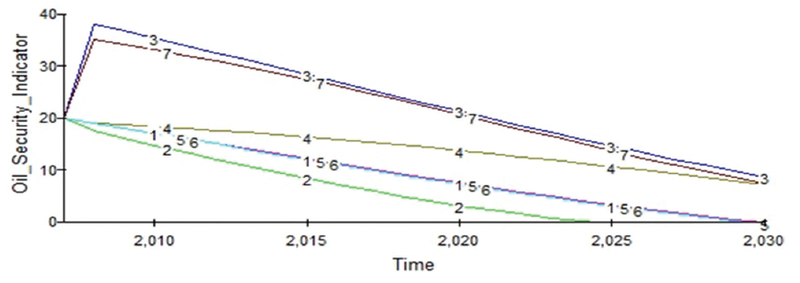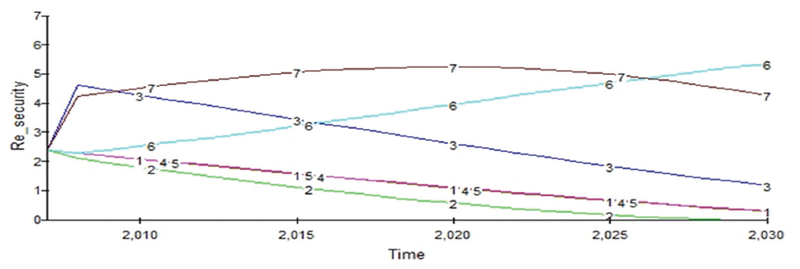Knowledge fuels change - Support energypedia!
For over 10 years, energypedia has been connecting energy experts around the world — helping them share knowledge, learn from each other, and accelerate the global energy transition.
Today, we ask for your support to keep this platform free and accessible to all.
Even a small contribution makes a big difference! If just 10–20% of our 60,000+ monthly visitors donated the equivalent of a cup of coffee — €5 — Energypedia would be fully funded for a whole year.
Is the knowledge you’ve gained through Energypedia this year worth €5 or more?
Your donation keeps the platform running, helps us create new knowledge products, and contributes directly to achieving SDG 7.
Thank you for your support, your donation, big or small, truly matters!
Egypt's Energy Security - Challenges & Possible Futuristic Scenarios
Introduction
Despite the lack of profound resources and information, and the ambiguity of available data regarding energy security in Egypt, yet Atlam & Rapiea (2016)’s study on “Assessing the Future Energy Security in Egypt” can be used as a firm basis for investigating the energy security situation in the country.
Across the globe, securing energy supplies at good prices, with the ability to meet national demand on both short and long terms is considered a top priority for any country that aims to achieve energy security as a top-priority national goal[1].
Yet, energy security around the world faces two major challenges: the 1st is the rapid growth of population and the parallel critical increase in demand for energy, while the 2nd is to provide such increasing demand with clean and safe energy, with a minimum negative impact upon the environment[1].
Egypt's Energy Security Major Challenges
- The declining of Egyptian oil and natural gas reserves; as proved oil reserves have decreased from 4.5 million barrel in 2009 to 4.2 million barrel in 2013, while natural gas reserves have decreased from 78 trillion cubic feet in 2010 to 77.2 trillion cubic feet in 2014[1].
- The fact that the current Egyptian energy mixture is not properly diversified, as Egypt, heavily and mainly depends on oil, natural gas and the hydroelectric power from the Nile, with the third being close to nothing and even descending more, then Egypt is left with only both oil and natural gas representing approximately 94.4% of the total primary energy consumption till 2014[1].
- The gap between supply and demand of oil, since the supply ratio is about 52.7% of the demand[1].
- The majority of the Egyptian imported oil (~4.9 million tons), comes only from three suppliers: Kuwait, Iraq and Oman –according to the Egyptian Ministry of Petroleum- in 2014[1]. Such a low variety of oil importers increases the probability of the risk of Egypt being negatively affected by any geopolitical instabilities in one or all of these importers, consequently affecting its ability to secure domestic demands in such situations[1].
- The low percentage of private investment in the energy sector (~16% in 2014/15), which in a way confines and hinders the technological aspects of energy production, distribution and consumption[1].
- The aging, un-maintained, low to non-efficient, mal-planned Egyptian infrastructure, especially in the energy sectors, which when faced with any sign of major problem, would lead to catastrophic outcomes, as for example, the daily blackouts of 2013 and 2014 summers, where electricity used to be completely absent allover Egypt for 6-8 hours/day through different times of the day[1].
- The non-existence of clear, to the point and profound strategies to be properly integrated in the Egyptian energy sector, and the un-clarity and complete randomness of the existent mixed ones, which are mostly unreliable, un-applicable strategies designed by totally different and varied institutions and energy-suppliers with different agendas and mentalities, eventually hindering any possible appropriate application or planning a proper solution(s) to secure energy supply[1].
Different Possible Scenarios of Egypt's Futuristic Energy Security
With the basis of the mentioned challenges, and for assessing the futuristic Egyptian energy security situation as accurately as possible, Atlam & Rapiea (2016) used the System Dynamic Approach, which was introduced in the mid-50s as a system simulation methodology to understand, visualize and analyze complex dynamic feedback systems, and they applied that by simulating different seven possible scenarios for the period 2007-2030: Business as Usual scenario (BAU), Economic Growth scenario (EG), Energy Subsidy Removal scenario (ESR), New Discoveries scenario (ND), Population Growth scenario (PG), New and Renewable scenario (NR) and Multiple Policies scenario (MP), which produced the following results represented in graphs[1]:
For the BAU scenario, the graphs showed that there will be a reverse relation between the availability of energy resources and the total energy consumption, meaning, a significant decline in the energy security indicator between 2007-2030, as the value of the indicator is expected in this case to decrease from 40.6 to only 4 years[1]. Through this scenario, oil resources are expected to be completely depleted by 2029, natural gas to be the sole-source for energy consumption for 4 years by 2030, while renewables will be completely ineffective, assuming the current situation remains the same[1].
As for the EG scenario, the graphs showed the weakest energy security performance in 2030, as the total energy resources are to be fully depleted by 2027, oil to be totally consumed by 2028, and natural gas to be completely exploited by 2022, meaning that after 2028/29 securing energy will be completely dependent on oil and natural gas imports[1].
However, the ESR scenario showed improvements in the energy security performance, when compared to previous ones. In this case, the energy security indicator’s value rose up to 20.4 years by 2030, since oil is found to cover total consumption up to 9 years, while natural gas is up to 15 years[1].
While the ND scenario showed the best energy security performance of all the proposed ones, particularly in the period 2027-2030, as the energy security indicator value reaches about 25.8 years by 2030, where oil’s indicator was for 8.4 years and natural gas was up to 22 years[1].
The PG scenario showed another decline in the energy security indicator, as its value went down from 40.6 years in 2007 to 4.9 years by 2030, where oil would run out by 2030, and natural gas would cover for about 4.6 years by 2030[1].
The highest contribution of renewables in securing energy in Egypt occurred under the scenario NR, as with accordance to this scenario, renewables are expected to contribute by approximately 59% of the Egyptian energy mix by 2030, while combined with natural gas, they will cover energy consumption for 10.2 years (4.2 for NG and 6 for renewables), and oil will be fully depleted by that time[1].
For the final scenario, MP showed that the energy security indicator was about 24.8 years by 2030, as the energy mix in Egypt would include 13.3% oil, 68.2% natural gas and 18.5% renewables, indicating 7.7 years for oil, 17 years for natural gas and 4.5 years for renewables[1].
In conclusion, assuming the continuity of the current Egyptian economic, social, environmental and energy policies and approaches, that eventually would have a negative impact on the future of energy security in the country, as the indicators declined in almost all the scenarios with one exception[1].
Yet, improving energy policies, applying more investments in fossil fuels discoveries, removing energy subsidies –which is already being carried out by the current government- and increasing usage and investment rate of renewables, are expected to slightly improve the energy security indicator for the coming few years[1].
References
- ↑ 1.00 1.01 1.02 1.03 1.04 1.05 1.06 1.07 1.08 1.09 1.10 1.11 1.12 1.13 1.14 1.15 1.16 1.17 1.18 1.19 1.20 Atlam, B. and Rapiea, A. (2016). Assessing the Future of Energy Security in Egypt. International Journal of Energy Economics and Policy. Vol, 6(4): 684-700. Retrieved From: http://www.econjournals.com/index.php/ijeep/article/view/2777/1930





























